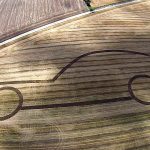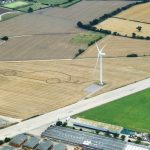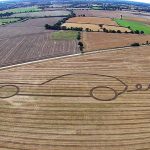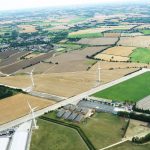Article by Kate Royall.
The question of renewable energy has been thrown into the spotlight thanks to an ambitious piece of land art. An electric car, spanning more than 200 metres, has appeared in a secluded field in north Suffolk. The stunning sight was etched into an Eye field next to a set of wind turbines.
The car, which looks as though it’s powered by the turbine raises questions about whether electric cars could ever be powered directly by turbines. The artwork is the most recent collaboration between Eye residents Carlo Roberts and Stefan Fulcher who have previously etched a B-17 bomber and the Olympic rings into surrounding fields.
Mr Roberts, a geography teacher at Sprowston High School who has a background in community art, said:
“I’m interested in art that relates to the locality and views from above. Ever since I did an art degree as a mature student I’ve been obsessed with aerial views. What I was really interested in was combining a real object with a drawn object. After a trip to London, I was amazed at the amount of electric cars there, it got me thinking about electric cars and how few there seem to be in the countryside. The idea of having a turbine powering a car seemed very interesting.”
The pair’s first foray into the art form saw a set of Olympic rings drawn into the earth in 2012, followed by a remembrance poppy in 2014 and a B-17 bomber in 2015. This most recent etching was given the green light by landowner Tom Baldwin. Mr Roberts, 49, used satellite maps to produce a scale drawing of the outline before heading out into the field with the help of 16-year-old student Samuel Seymour.
After marking out the base line of the car in the wheat stubble, they scaled up his original drawing using a surveyors instrument to measure the angles from the base line, setting out 12 reference points for the tractor driver to follow. The outline was then ready for Mr Fulcher to plough in using a set of discs ordinarily used to break up and cultivate top soil.
Mr Roberts said: “All I tried to do was get something that said car very simply, the design is half practical and half sporty looking. What’s brilliant about the fields is you get a lot of straight lines on them where the wheat was planted and tramlines every 24 metres or so. I used one to plot the base line. Stefan is the skill behind it, he’s got a very good eye.”
Marking out took five hours, while discing took a mere 90 minutes and the pair’s handiwork was initially checked with the help of a hexacopter, manned by Andrew Turner from the Mid Suffolk Radio Control Modellers group.
Mr Roberts said: “It wouldn’t have happened without Stefan and Tom. “I’m just amazed and feel very privileged that I can do it. The thing we are always up against is fitting it in with the agricultural calendar and when the tractors are free.”
The artists are already working on plans for a future large-scale artwork.




